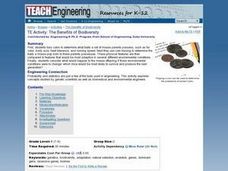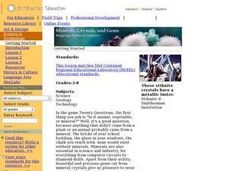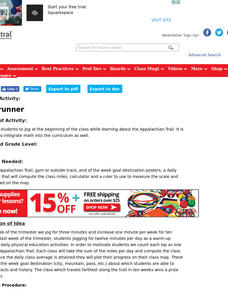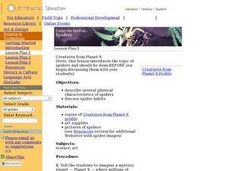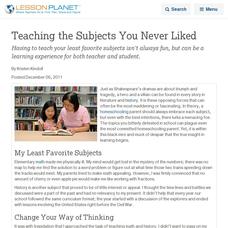Curated OER
Construction Technologies: Construct the Strongest Bridge
Middle schoolers investigate how engineers use different types of bridges for different places. In small groups they design and construct bridges for three different scenarios, and answer a series of investigating questions applied to...
Curated OER
My Car Has Potential
Seventh graders investigate how changes in the mass or height of a ramp can affect the change in potential energy. They discuss the concepts of work and energy, then using the four question strategy, they design an experiment that...
Curated OER
America's Pastime
Students relate Newton's Laws of Motion to the game of baseball. They compare and contrast the materials used in baseballs that could affect their performance. They also determine how friction can be increased or decreased in a ballpark.
Curated OER
Make a Model of a Wright Flyer
Students recreate a model of the 1903 Wright Flyer out of Styrofoam. Students practice following instructions, and discover information about the Wright brothers' engine-powered glider.
Curated OER
Family Fitness
Students visit sites that contain information about a variety of health and fitness activities. They analyze the activities according to several criteria, and describe how their particular activity choices can contribute to a healthy...
Curated OER
What is Taxed and Why
Learners are exposed to the need for federal, state and local governments to tax constituents to provide goods and services for their residents. They identify the different kinds of taxes and give examples of the goods and services taxed.
Curated OER
Riding the Gravity Wave
Students write a sketch of an artist or athlete that has pushed the limits on gravity. They explore concepts of rhythm, balance and friction. They examine how engineers design sports equipment.
Curated OER
The Benefits of Biodiversity
Pupils examine the concept of biodiversity. They toss coins to determine what traits mouse parents have and the babies traits as well. They predict what would happen to the baby mice if the traits of the parents were different.
Curated OER
Predicting Severe Weather
Students recognize the range and variety of severe weather. They plan for severe weather conditions that they may experience on an immediate and long-term scale and use climate information to make personal choices about where to live and...
Curated OER
Minerals, Crystals, and Gems
Students discover the relationships between minerals, crystals and gems. They bring in rocks that they find at home, in the schoolyard, etc. and examine them and attempt to identify them. They set up a classroom exhibit that includes all...
Curated OER
Severe Weather - Deciding Where to Live
Young scholars recognize the variety and frequency of severe weather occurrences. They research the type of severe weather that may occur in their area as well as determine the frequency of occurrence.
Curated OER
Seeing the World Through A Different Lens
Students participate in activities in which they model different disabilities. They discuss their experiences as a class. They work together in groups to discuss how to improve an adaptive device.
Curated OER
The Squeeze is On
Students investigate the force of compression and how it acts on structural components through a hands-on group project. They use everyday products such as paper, toothpicks, and tape to construct a structure that will support the...
Curated OER
Climate and Cultures of Africa
Students gain an understanding of the relationship between climate and culture in the sub- Saharan Africa. Students will complete short exercises pertaining to the various cultures of Africa and the climate in which they live....
Curated OER
Ridgerunner
Learners jog for three minutes at the beginning of the class, increasing one minute per week for ten weeks. They count each lap as one mile on the Appalachian Trail, computing the class average and plotting their progress on a class map.
Curated OER
Aerobic Frisbee Golf
Students work cooperatively to accurately throw a Frisbee in order to learn about fitness components and different systems of the human body.
Curated OER
Creatures from Planet X: Spiders
Students are given a description of some fascinating animals from "Planet X". They follow the descriptions given to illustrate one of these animals paying careful attention to introduced vocabulary such as 'appendages', 'receptors', and...
Curated OER
Civil Rights and the ADA
Middle schoolers examine and discuss the 14th and 15th amentments, and evaluate the agendas of Americans from underrepresented groups in the quest for civil rights. They conduct Internet research and create essays or posters regarding...
Curated OER
Adaptable Mandibles
Young scholars define adaptation and highlight example of adaptation in birds and other animals. They study feeding techniques of seabirds and investigate the effect that trash has on wildlife.
Curated OER
Memory Book - A Cooperative Learning Experience
Students document sections of their life through pictures, stories, and video to create an English "memory book". They use photographs, video and edited video which includes their history, includes calculated growth, and genetic...
Curated OER
Teaching the Subjects You Never Liked
Having to teach your least favorite subjects isn't always fun, but can be a learning experience for both teacher and student.
Curated OER
Pictures Telling Stories
Learners see the importance of primary sources in the study of history, but also the limitations of relying only on primary sources of taking the money, as it were, at face value.
Curated OER
Spy on a Spider
Learners view slides or live specimens to name and describe the distinguishing features of groups of arthropods, especially spiders and insects. They complete worksheets, observe webs and then search for and record where spiders can be...
Curated OER
Discover the Similarites
Students research a choosen career on the internet. They gather pertinent and interesting information about their choosen career and construct a display for the career along with a written report which is displayed in class.







